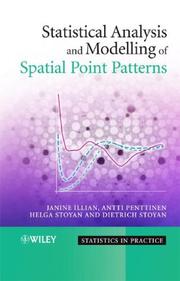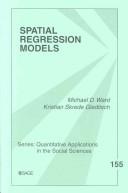| Listing 1 - 4 of 4 |
Sort by
|

ISBN: 9780470014912 0470014911 Year: 2008 Publisher: Chichester, England : John Wiley,
Abstract | Keywords | Export | Availability | Bookmark
 Loading...
Loading...Choose an application
- Reference Manager
- EndNote
- RefWorks (Direct export to RefWorks)
Spatial point processes are mathematical models used to describe and analyse the geometrical structure of patterns formed by objects that are irregularly or randomly distributed in one-, two- or three-dimensional space. Examples include locations of trees in a forest, blood particles on a glass plate, galaxies in the universe, and particle centres in samples of material. - Numerous aspects of the nature of a specific spatial point pattern may be described using the appropriate statistical methods. Statistical Analysis and Modelling of Spatial Point Patterns provides a practical guide to the use of these specialised methods. The application-oriented approach helps demonstrate the benefits of this increasingly popular branch of statistics to a broad audience. [Back cover]
Periodical
Abstract | Keywords | Export | Availability | Bookmark
 Loading...
Loading...Choose an application
- Reference Manager
- EndNote
- RefWorks (Direct export to RefWorks)
Environmental planning --- Business economics --- Demography --- Economics --- Spatial analysis (Statistics) --- Space in economics --- Analyse spatiale (Statistique) --- Espace (Economie politique) --- Periodicals. --- Périodiques --- Space in economics. --- Social Sciences --- Communities and Urban Planning --- Public Policy & Administration

ISBN: 9781412954150 Year: 2008 Publisher: Thousand Oaks : Sage Publications,
Abstract | Keywords | Export | Availability | Bookmark
 Loading...
Loading...Choose an application
- Reference Manager
- EndNote
- RefWorks (Direct export to RefWorks)
Mathematical statistics --- Spatial analysis (Statistics) --- Regression analysis. --- Analyse spatiale (Statistique) --- Analyse de régression --- #SBIB:303H10 --- #SBIB:303H520 --- Methoden en technieken: algemene handboeken en reeksen --- Methoden sociale wetenschappen: techniek van de analyse, algemeen --- Spatial analysis (Statistics). --- Analyse de régression --- Regression analysis --- Analysis, Spatial (Statistics) --- Correlation (Statistics) --- Spatial systems --- Analysis, Regression --- Linear regression --- Regression modeling --- Multivariate analysis --- Structural equation modeling --- Wiskundige statistiek
Periodical
Abstract | Keywords | Export | Availability | Bookmark
 Loading...
Loading...Choose an application
- Reference Manager
- EndNote
- RefWorks (Direct export to RefWorks)
Applied Spatial Analysis and Policy draws on spatial analysis for the assembly and interpretation of evidence, addressing such issues as crime and deprivation, immigration and demographic restructuring, retail activity and employment change, resource management and environmental improvement. The journal draws on applied research from such sources as transport, policing, education, health, environment and leisure to offer comparative policy analysis between domains and locations, and to stimulate ideas on the application of spatial analysis methods across varied policy contexts.
Sociology --- Social Sciences --- Public Policy & Administration --- Communities and Urban Planning --- Spatial analysis (Statistics) --- Geographic information systems --- Geographic information systems. --- Analyse spatiale (Statistique) --- Systèmes d'information géographique --- sociale geografie --- social geography --- sociale ecologie --- human ecology --- mens --- man --- demografie --- demography --- ruimtelijke analyse --- spatial analysis --- Social Geography --- Sociale geografie --- Analysis, Spatial (Statistics) --- Correlation (Statistics) --- Spatial systems --- Geographical information systems --- GIS (Information systems) --- Information storage and retrieval systems --- Geography
| Listing 1 - 4 of 4 |
Sort by
|

 Search
Search Feedback
Feedback About
About Help
Help News
News